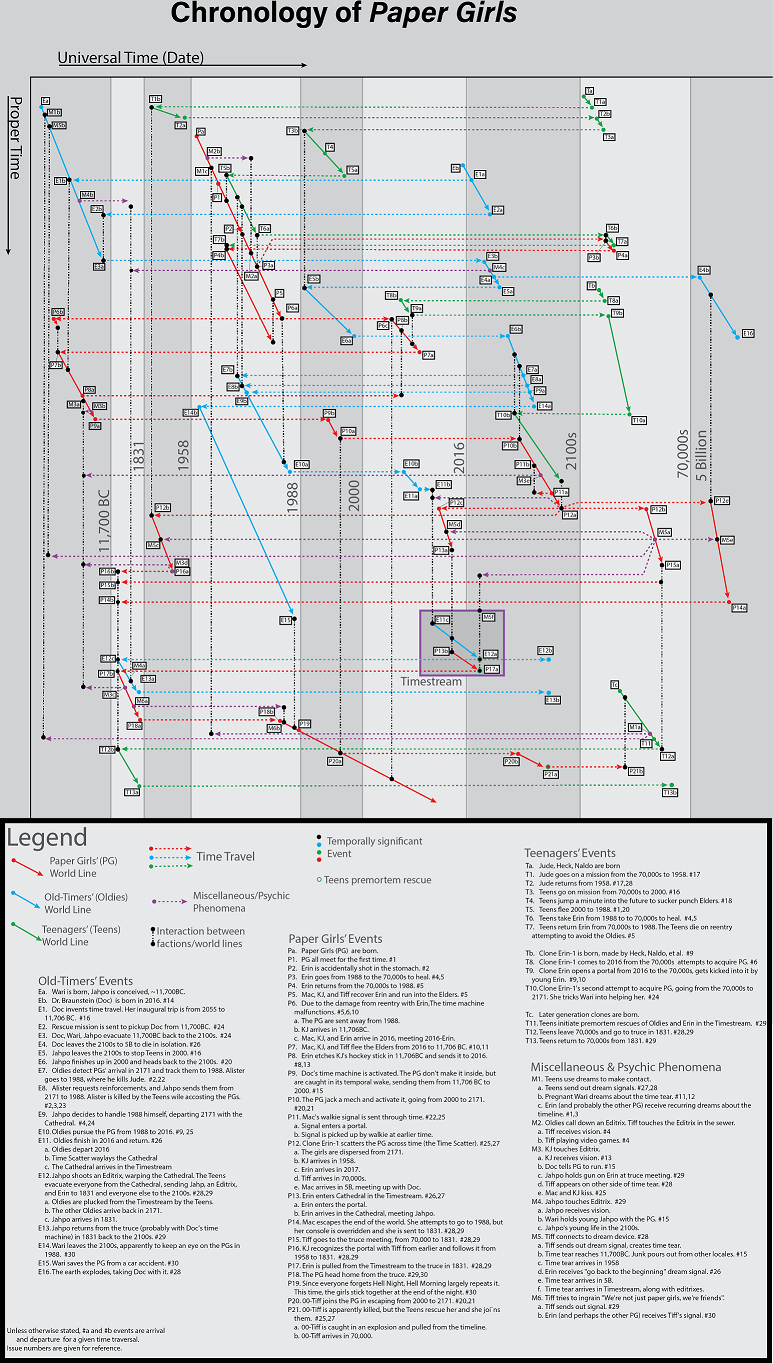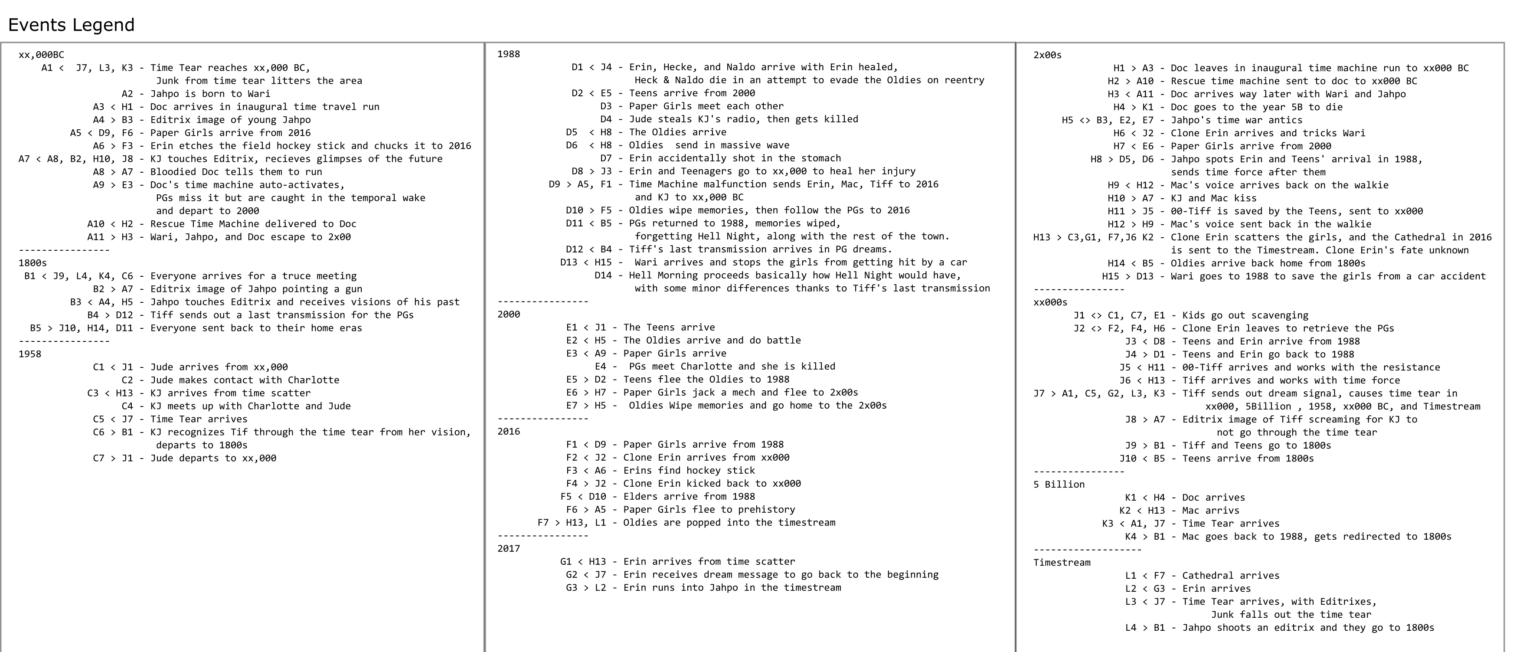
A while back, as part of my research for The Chronoversal Compendium, I posted some diagrams of the timeline from the comic book series Paper Girls, by Brian K. Vaughan (I even got a shoutout from the man himself, which I was super jazzed about).
I was ultimately unsatisfied with these diagrams, though. Sure, they look pretty, like a woven tapestry, but getting information out of them is…not so easy. There were also a few mistakes in them that I hadn’t noticed. So I decided to reexamine it to try and make the chronology clearer. And now that I have my own website, I can expand on it!
About Paper Girls
Paper Girls follows the journey of Mac, KJ, Tiffany, and Erin, a group of 12-year-old paper girls delivering newspapers on the morning of November 1, 1988. The setting brings to mind 1980s nostalgia grabs, like Stranger Things, IT, and Dark. Paper Girls, as you might have guessed from the premise of this essay, does not stay in the 80s. The girls find themselves caught in an intertemporal conflict that takes them and the combatants of both sides all over time.
I was originally planning to summarize the whole story for those of you that haven’t read it, but there are 30 issues, over 900 pages, and over 100 temporally significant events. Look, if you’re not familiar with Paper Girls, I’m afraid you probably won’t get much out of this. You should read it yourself, it’s a good series.
The Temporal Mechanics of Paper Girls
For reference, I’m going to be using these definitions for time travel terminology.
There is a great deal of criss-crossing of world lines in Paper Girls. Characters move forward and backward in time and we see how Event A causes Event B causes Event C which looks like it causes Event A again. There aren’t any contradictions between all the events we observe, so based on what we see, it seems like a simple case of having a Single Static Timeline–the past and future are set and cannot be changed.
Except.
We are told directly that the timeline has been changed. Many times, in fact, however subtly they may have been. The timeline is therefore either not single or not static. Generally, if the past can be changed, we default to multiple timelines, however there are indications that the changes are made to the same singular timeline. We are told directly by the scientist who discovered time travel that the timeline can be overwritten like a cassette tape (and similarly degrades each time), and Clone Erin-1 tells us there are no alternate universes. The existence of diachronic communication (characters travel back in time can keep in radio contact with their base in the future), and portals between points in time all point to a single timeline that is mutable–a Dynamic Timeline.
Additionally, we are told that the most it could be changed was moving a few events around by a few weeks And each change potentially wears down the fabric of spacetime. Historical inertia is in play–the timeline is resistant to change, making it Elastic as well as Dynamic. So we have our final designation: an Elastodynamic Timeline.
Timeline Iteration
While the causes become more and more circular as the timeline changes, there are discernable causal links between the various groups of time travel events: Doc’s initial traversal creates the folds –> which are used by the Teens –> which draws out the Old-Timers–> which drags in the Paper Girls–> leading to the version of events we see. So the changes to the timeline seem to come in stages, which can be grouped together like overall versions of the timeline:
- Origination. There aren’t any incursions in the past. In 2055, Doctor Qanta Braunstein (I’m going to call her Doc) discovers time travel and goes back to 11,706BC. This creates folds in the timeline.
- Proliferation. Doc brings Wari & Jahpo to the future. The Teenagers discover & use portals to “improve” the timeline.
- Conflict. The Old-Timers discover the incursions of the Teenagers and attempt to mitigate changes to the timeline.
- Escalation. The conflict between the Teenagers and Old-Timers grows, dragging the Paper Girls into the conflict.
- Culmination. Tiffany joins the Teenagers, giving the catalyst necessary to end the conflict.
- Resolution. The factions reach an armistice.
Much like the stages of a story, no? There are likely dozens (one character claims millions, but this might be an exaggeration) of traversals and iterations in each stage. The final iteration in Resolution is likely what we see at the very end of Paper Girls. It is largely identical to the previous iteration except the Paper Girls stick together and have a stronger friendship than previously. While they may live happier lives, this will have a relatively small effect on the larger timescale, which is fine because by 70,000 AD humanity seems to have everything figured out. In theory, at this point we will have a big time loop–all the attempts to change the timeline will just result in the observed events. The final iteration will be indistinguishable from a Single Static Timeline.
The Timeline of Paper Girls
So here is the new and improved diagram. I’ve expanded it into two dimensions to untangle the weave of the original. Now we still have the horizontal axis being universal time, but we also have a vertical axis representing proper time. The further down you go, the later in a given faction’s lifespan we have gone.
It should be noted, of course, that none of this is to scale–we see that 5 Billion year timespan is the same length as 1988. Events are in their relative positions, but the slopes and distances vary to what is the easiest to organize.
Click here to open this image directly.

Additional Info
Eras
The events of Paper girls take place over the following eras:
- 11,700 BC (The years surrounding 11,706 BC). Doc and the PG arrive in 11,706 BC, in which Jahpo is already born and the time tear already exists.
- 1831 (August 02, 1831). The truce meeting.
- 1958. Jude recruits Charlotte.
- 1988. Hell Night. The PG home era.
- 2000. The recruitment of 00-Tiff, and a large-scale battle between Elders and Teens.
- 2016 (2016-2017). The PG are accidentally sent here, followed closely by the Elders.
- 2100s (2018-2171). Doc invents time travel. The Elders home base is this era.
- 70,000s. The distant future, this is where the Teens launch from. We don’t know much about the intervening years, but humanity seems to be doing quite well by this point.
- 5B (~5,000,000,000). The earth is destroyed.
In general, I will refer to time periods using these era designations rather than specific dates.
Factions
Perhaps the most appropriate way to organize events is as they are experienced by the factions in question. That is, we will organize them by proper time, following the world lines of each respective faction. The three main factions are:
- The Paper Girls (PG). Erin, KJ, Mac, Tiff, and their older selves.
- The Old-timers/Elders/Oldies, plus natives of the 21st and 22nd centuries. This includes Dr. Braunstein, Wari, and Jahpo.
- The Teenagers. This includes Jude, Heck, Naldo, the clones of the PGs, and eventually Tiff.
- We will also separately categorize Miscellaneous and Psychic phenomena.
Original diagrams
For reference, here is the previous set of diagrams. I included an additional faction (civilians), which I wrapped into the existing factions in the newer version.







